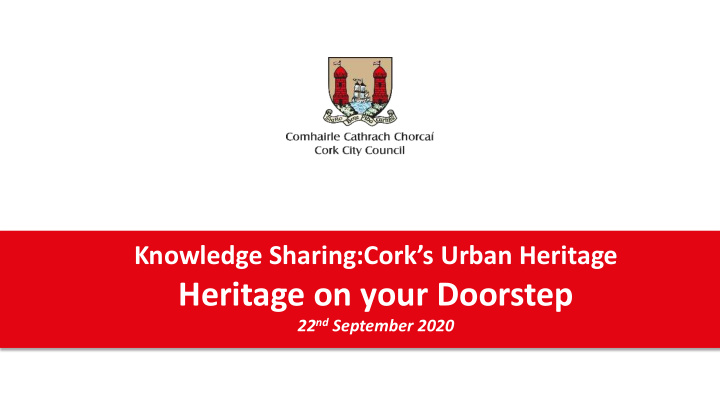



Click to edit Master title style Click to edit Master title style Knowledge Sharing:Cork’s Urban Heritage Heritage on your Doorstep 22 nd September 2020
What is Heritage? Click to edit Master title style The physical evidence of a story -Who we are -Where we came from -Where we might be going
Click to edit Master title style The Heritage of Cork City maps and mirrors the varied and continuous changes in Cork and its citizens from the Vikings through the Victorians to the modern day.
Click to edit Master title style Fr From om Tha hat ..... ..... • T To This Statio Bene Fide Carinis A Safe Harbour for Ships
Medieval Origins Click to edit Master title style
Cork – A Walled City Click to edit Master title style
Click to edit Master title style CORK Medieval City Wall Grand Parade
Click to edit Master title style CORK Red Abbey
Red Abbey Click to edit Master title style • Built by the Augustinians in 1270 to 1288 • Last remaining relic from the Anglo-Norman era • A wealthy abbey in its day, owning two watermills and a salmon fishery near South gate Bridge • Used during the Siege of Cork in 1690 • Used as a sugar refinery in the mid-eighteenth century • Accidently burnt down in 1799 • Ruined Bell tower remains today
Click to edit Master title style CORK Huguenot Cemetery, Carey’s Lane Before Restoration
Click to edit Master title style CORK Huguenot Cemetery
Huguenot Cemetery Click to edit Master title style
Click to edit Master title style CORK Christ Church, South Main Street • Holy Trinity • Parish Church of Hiberno- Norse Cork • Present Church dates to 1726 • Crypt (older, medieval elements) • Associated Graveyard
Click to edit Master title style CORK Christ Church Before Restoration
Click to edit Master title style CORK Christ Church After Restoration
Christ Church Crypt – Before Restoration Click to edit Master title style
Christ Church Crypt - Viewing Box After Restoration Click to edit Master title style
Fenn’s Quay Click to edit Master title style
Frank O Connor House, 84 Douglas Street Click to edit Master title style
Click to edit Master title style CORK But Heritage is not only about architecture...
Look up and around......... Click to edit Master title style
Sign on Pembroke Street Click to edit Master title style Mayne’s Pharmacy
Click to edit Master title style North Main Street Medieval Laneways
Armorial Plaque and Information at The Raven South Main Click to edit Master title style Street
Click to edit Master title style Madraí Water Trough • Madraí Water Trough • Located at 124 St. Patrick’s Street, near the Fr. Mathew statue • Sculptor Seamus Murphy commissioned by the owners of a restaurant at this location in the 1950’s to carve a trough for the patrons dogs.
Click to edit Master title style CORK Canon, Grand Parade
Title to go here Click to edit Master title style • Cast-iron cannon gun protruding vertically from the pavement outside Bishop Lucey Park on the corner of the Grand Parade and Tuckey Street. • During the 2006/7 survey, the cannon was retained in situ and incorporated into the Grand Parade Streetscape Renewal Scheme. • The surface paving around the cannon was reduced as part of the scheme. The button, cascabel, and base ring are clearly visible at the top of the bollard.
Standing Stone Ardmahon Estate Click to edit Master title style
Standing Stone, Ardmahon Estate Click to edit Master title style Standing stones known as Dalláns or Galláns in Irish, are intriguing simple monuments. They probably functioned as prehistoric burial markers, commemorative monuments associated with ritual, meeting places or indicators of routeways or boundaries and date from the Bronze and Iron Ages (c. 2400 BC - AD 500). They consist of a single stone which has been deliberately set upright in the ground, and usually have their long axis orientated on a north- east-south-west orientation, Standing stones are widely distributed in Ireland, with over approx. 300 recorded in County Cork (Power, 1992).
Recommend
More recommend